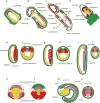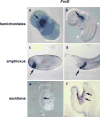On a possible evolutionary link of the stomochord of hemichordates to pharyngeal organs of chordates
- PMID: 25303744
- PMCID: PMC5673098
- DOI: 10.1002/dvg.22831
On a possible evolutionary link of the stomochord of hemichordates to pharyngeal organs of chordates
Abstract
As a group closely related to chordates, hemichordate acorn worms are in a key phylogenic position for addressing hypotheses of chordate origins. The stomochord of acorn worms is an anterior outgrowth of the pharynx endoderm into the proboscis. In 1886 Bateson proposed homology of this organ to the chordate notochord, crowning this animal group "hemichordates." Although this proposal has been debated for over a century, the question still remains unresolved. Here we review recent progress related to this question. First, the developmental mode of the stomochord completely differs from that of the notochord. Second, comparison of expression profiles of genes including Brachyury, a key regulator of notochord formation in chordates, does not support the stomochord/notochord homology. Third, FoxE that is expressed in the stomochord-forming region in acorn worm juveniles is expressed in the club-shaped gland and in the endostyle of amphioxus, in the endostyle of ascidians, and in the thyroid gland of vertebrates. Based on these findings, together with the anterior endodermal location of the stomochord, we propose that the stomochord has evolutionary relatedness to chordate organs deriving from the anterior pharynx rather than to the notochord.
Keywords: chordates; hemichordates; notochord; pharyngeal organs; stomochord.
© 2014 Wiley Periodicals, Inc.
Figures



References
-
- Amemiya CT, Prohaska SJ, Hill-Force A, Cook A, Wasserscheid J, Ferrier DE, Pascual-Anaya J, Garcia-Fernandez J, Dewar K, Stadler PF. The amphioxus Hox cluster: Characterization, comparative genomics, and evolution. J Exp Zool B Mol Dev Evol. 2008;310:465–477. - PubMed
-
- Arnone MI, Rizzo F, Annunciata R, Cameron RA, Peterson KJ, Martinez P. Genetic organization and embryonic expression of the ParaHox genes in the sea urchin S. purpuratus: Insights into the relationship between clustering and colinearity. Dev Biol. 2006;300:63–73. - PubMed
-
- Balser EJ, Ruppert EE. Structure, ultrastructure, and function of the preoral heart kidney in Saccoglossus-Kowalevskii (Hemichordata, Enteropneusta) including new data on the stomochord. Acta Zool. 1990;71:235–249.
-
- Bateson W. The later stages in the development of Balanoglossus kowalevskii, with a suggestion as to the affinities of the Enteropneusta. Q J Microsc Sci. 1885;25:81–122.
Publication types
MeSH terms
Substances
Grants and funding
LinkOut - more resources
Full Text Sources
Other Literature Sources
Research Materials

